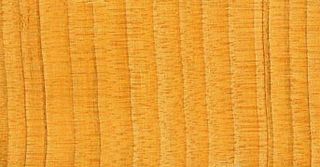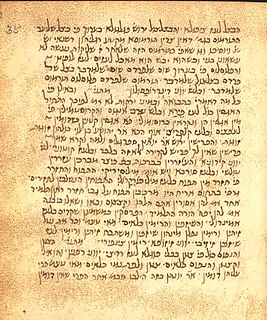Related Research Articles

Shlomo Yitzchaki, today generally known by the acronym Rashi, was a medieval French rabbi and author of a comprehensive commentary on the Talmud and commentary on the Hebrew Bible. Acclaimed for his ability to present the basic meaning of the text in a concise and lucid fashion, Rashi appeals to both learned scholars and beginner students, and his works remain a centerpiece of contemporary Jewish study. His commentary on the Talmud, which covers nearly all of the Babylonian Talmud, has been included in every edition of the Talmud since its first printing by Daniel Bomberg in the 1520s. His commentary on Tanakh—especially on the Chumash —serves as the basis for more than 300 "supercommentaries" which analyze Rashi's choice of language and citations, penned by some of the greatest names in rabbinic literature.

The Talmud is the central text of Rabbinic Judaism and the primary source of Jewish religious law (halakha) and Jewish theology. Until the advent of modernity, in nearly all Jewish communities, the Talmud was the centerpiece of Jewish cultural life and was foundational to "all Jewish thought and aspirations", serving also as "the guide for the daily life" of Jews.
The Zohar is a foundational work in the literature of Jewish mystical thought known as Kabbalah. It is a group of books including commentary on the mystical aspects of the Torah and scriptural interpretations as well as material on mysticism, mythical cosmogony, and mystical psychology. The Zohar contains discussions of the nature of God, the origin and structure of the universe, the nature of souls, redemption, the relationship of Ego to Darkness and "true self" to "The Light of God". Its scriptural exegesis can be considered an esoteric form of the rabbinic literature known as Midrash, which elaborates on the Torah.

Rabbinic literature, in its broadest sense, is the entire spectrum of rabbinic writings throughout Jewish history. However, the term often refers specifically to literature from the Talmudic era, as opposed to medieval and modern rabbinic writing, and thus corresponds with the Hebrew term Sifrut Chazal. This more specific sense of "Rabbinic literature"—referring to the Talmudim, Midrash, and related writings, but hardly ever to later texts—is how the term is generally intended when used in contemporary academic writing. The terms meforshim and parshanim (commentaries/commentators) almost always refer to later, post-Talmudic writers of rabbinic glosses on Biblical and Talmudic texts.

Hillel was a Jewish religious leader, sage and scholar associated with the development of the Mishnah and the Talmud and the founder of the House of Hillel school of tannaim.

The Tosafot,Tosafos or Tosfot are medieval commentaries on the Talmud. They take the form of critical and explanatory glosses, printed, in almost all Talmud editions, on the outer margin and opposite Rashi's notes.

Targum Jonathan is a western targum (interpretation) of the Torah (Pentateuch) from the land of Israel. Its correct title was originally Targum Yerushalmi, which is how it was known in medieval times. But because of a printer's mistake it was later labeled Targum Jonathan, in reference to Jonathan ben Uzziel. Some editions of the Pentateuch continue to call it Targum Jonathan to this day. Most scholars refer to the text as Targum Pseudo-Jonathan or TPsJ.
Rishonim were the leading rabbis and poskim who lived approximately during the 11th to 15th centuries, in the era before the writing of the Shulchan Aruch and following the Geonim. Rabbinic scholars subsequent to the Shulkhan Arukh are generally known as acharonim.
Samuel ben Meir, after his death known as "Rashbam", a Hebrew acronym for RAbbi SHmuel Ben Meir, was a leading French Tosafist and grandson of Shlomo Yitzhaki, "Rashi".
Bruriah is one of several women quoted as a sage in the Talmud. She was the wife of the Tanna Rabbi Meir and the daughter of Hananiah ben Teradion.
Tobiah ben Eliezer was a Talmudist and poet of the 11th century, author of Lekach Tov or Pesikta Zutarta, a midrashic commentary on the Pentateuch and the Five Megillot.

Sifra is the Halakhic midrash to the Book of Leviticus. It is frequently quoted in the Talmud, and the study of it followed that of the Mishnah. Like Leviticus itself, the midrash is occasionally called "Torat Kohanim", and in two passages also "Sifra debei Rav". According to Leḳaḥ Ṭob this latter title was applied originally to the third book of the Pentateuch because Leviticus was the first book studied in the elementary school, and it was subsequently extended to the midrash; but this explanation is contradicted by analogous expressions such as "Sifre debei Rav" and, in a broader sense, "ketubot debei Rav" and "teḳi'ata debei Rav".

Sifre refers to either of two works of Midrash halakha, or classical Jewish legal biblical exegesis, based on the biblical books of Numbers and Deuteronomy.

Metzora, Metzorah, M'tzora, Mezora, Metsora, M'tsora, Metsoro, Meṣora, or Maṣoro is the 28th weekly Torah portion in the annual Jewish cycle of Torah reading and the fifth in the Book of Leviticus. The parashah deals with ritual impurity. It addresses cleansing from skin disease, houses with an eruptive plague, male genital discharges, and menstruation. The parashah constitutes Leviticus 14:1–15:33. The parashah is made up of 4,697 Hebrew letters, 1,274 Hebrew words, 90 verses, and 159 lines in a Torah Scroll.
Samson ben Abraham of Sens ,was one of the leading French Tosafists in the second half of the 12th and the beginning of the 13th centuries. He was the most outstanding student and the spiritual heir of Rabbi Isaac ben Samuel ha-Zaken. He is referred also known as "the Rash" or "the Prince of Sens", and within Tosafot as "Rashba".
Jewish commentaries on the Bible are biblical commentaries of the Hebrew Bible from a Jewish perspective. Translations into Aramaic and English, and some universally accepted Jewish commentaries with notes on their method of approach and also some modern translations into English with notes are listed.

Shabbat is the first tractate of Seder Moed of the Mishnah and of the Talmud. The tractate deals with the laws and practices regarding observing the Jewish Sabbath. The tractate focuses primarily on the categories and types of activities prohibited on the Sabbath according to interpretations of many verses in the Torah, notably Exodus 20:9–10 and Deut. 5:13–14.
Talmudical hermeneutics defines the rules and methods for investigation and exact determination of meaning of the scriptures in the Hebrew Bible, within the framework of Rabbinic Judaism. This includes, among others, the rules by which the requirements of the Oral Law and the Halakha are derived from and established by the written law.

Isaac ben Melchizedek, also known by the acronym Ribmaṣ, was a rabbinic scholar from Siponto in Italy, and one of the first medieval scholars to have composed a commentary on the Mishnah, although today only Seder Zera'im survives. Elements of the Mishnaic order of Taharot are also cited in his name by the Tosafists, but the complete work is no longer extant.
References
- ↑ J. Starr, The Jews in the Byzantine Empire, New York 1939, pp. 61–62